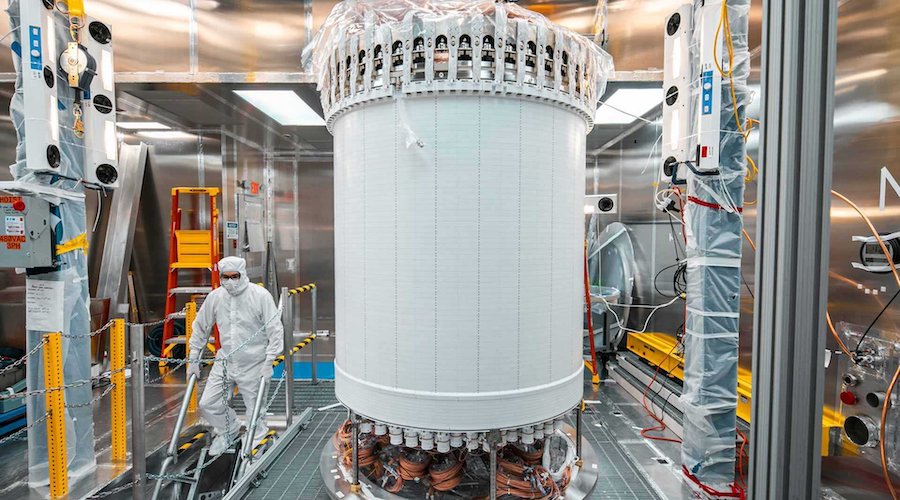Staff Writer | February 7, 2023 |

In a South Dakota gold mine, a research team is hunting for a yet-undiscovered particle that could explain dark matter. (Image by Matthew Kapust, courtesy of the Sanford Underground Research Facility).
An interdisciplinary team of researchers is working to lure a hypothesized particle from outer space to the Sanford Underground Research Facility, housed in a former gold mine that operated at the height of the 1870s gold rush in the town of Lead, South Dakota.

In detail, they are prospecting for WIMPs —weakly interacting massive particles— which are thought to have formed when the universe was just a microsecond old and which may exist unseen all around us. The research facility suits this type of search because the depth prevents the intrusion of cosmic rays, which would otherwise interfere with experiments.
If WIMPs are observed, they could hold clues to some of the most perplexing problems in physics: the nature of dark matter and the very structure of the universe itself.
The US-based group is using the Large Underground Xenon-ZEPLIN (LZ) experiment, the most sensitive WIMP dark matter detector located at the Sanford Lab. Unlike experiments conducted at particle smashers like the Large Hadron Collider (LHC) in Switzerland, the LZ attempts to directly observe—rather than manufacture—dark matter.
Anwar Bhatti, a research professor at the University of Maryland, said there are pros and cons to both approaches.
In his view, the odds of finding irrefutable proof of WIMPs are slim, but he hopes previously undiscovered particles will show up in their experiment, leaving a trail of clues in their wake.
“There’s a chance we will see hints of dark matter, but whether it’s conclusive remains to be seen,” Bhatti said.
An underground mine – the perfect location
Lead scientist Carter Hall explained that these direct searches for dark matter can only be conducted underground because researchers need to eliminate surface-level cosmic radiation, which can muddle dark matter signals and make them easier to miss.
“Here, on the surface of the earth, we’re constantly being bathed in cosmic particles that are raining down upon us. Some of them have come from across the galaxy and some of them have come across the universe,” Hall explained. “Our experiment is about a mile underground, and that mile of rock absorbs almost all of those conventional cosmic rays. That means that we can look for some exotic component which doesn’t interact very much and would not be absorbed by the rock.”
In the LZ experiment, bursts of light are produced by particle collisions. Scientists then work backward, using the characteristics of these flashes of light to determine the type of particle.
The UMD research group calibrates the instrument that powers the LZ experiment, which involves preparing and injecting tritium—a radioactive form of hydrogen—into a liquefied form of xenon, an extremely dense gas. Once mixed, the radioactive mixture is pumped throughout the instrument, which is where particle collisions can be observed.
The researchers then analyze the mixture’s decay to determine how the instrument responds to background events that are not dark matter. By process of elimination, the researchers learn the types of interactions that are—and aren’t—important.
“That tells us what dark matter does not look like, so what we’re going to be looking for in the dark matter search data are events that don’t fit that pattern,” Hall said.
The researcher also pointed out that they will not know if they found dark matter until their next data set is released. This could take at least a year.
If detected, these WIMP particles would prompt a massive overhaul of the Standard Model of particle physics, which explains the fundamental forces of the universe. While this experiment could answer pressing questions about the universe, there is a good chance it will also create new ones.
“It would mean that a lot of our basic ideas about the fundamental constituents of nature would need to be revised in one way or another,” Hall said.
No comments:
Post a Comment